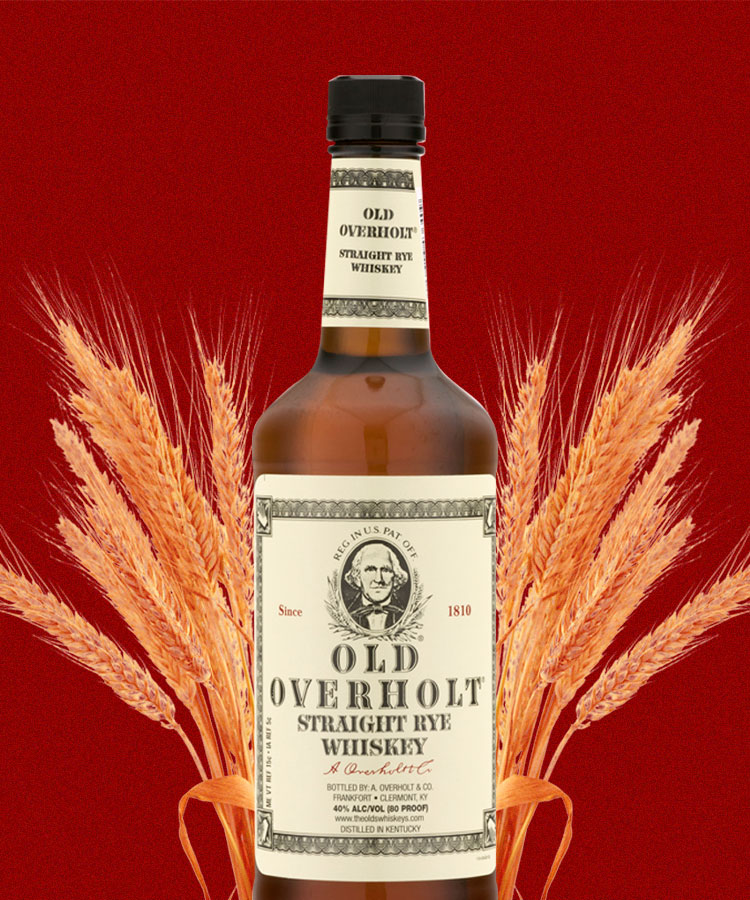
This article is part of a series, Stories of Bourbon, sponsored by James B. Beam Distilling Co. Discover more about bourbon here!
There are few images more iconic in American whiskey than the visage of one Abraham Overholt scowling in a black and white drawing on the label for his eponymous rye whiskey. And, though Old Overholt’s label has (mostly) looked the same for nearly 150 years, America’s oldest, continuously-maintained whiskey brand has had a wild, rollicking history over its 211-year-old existence, seeing it change states, recipes, and favor in the country’s drinking firmament, while always remaining true to its humble origins.
“I like to describe Old Overholt as the OG of American rye whiskey,” says Bradford Lawrence, Rye Whiskey Specialist at Beam Suntory.
While the epicenter of the American whiskey world stands today in Kentucky, it wasn’t always that way. Early immigrants from Europe settled in places like New England, New York, Virginia, and Pennsylvania, distilling whatever excess crops they had. One such German immigrant, Henry Oberholzer, landed in West Overton in Western Pennsylvania around 1800. A Mennonite farmer, Oberholzer—who would Anglicize his name into Overholt—also began distilling the rye grain that was bountiful in the area.
By 1810, Henry’s son Abraham Overholt, just age 26, had turned this little farm distillery into a legitimate business, distilling 50,000 gallons of rye per year. By mid-century it had become one of the top whiskey producers in the U.S., incorporated as A. Overholt & Co. They were able to produce 860 gallons of rye whiskey per day at West Overton distillery (which still stands to this day) and in nearby Broad Ford. By 1888 the company had officially taken the Old Overholt name and Abraham’s famous portrait was finally on the bottle.
“We’re one of few brands to overtly pay homage to our namesake, and I think it brings so much character to this brand,” adds Lawrence. “With an unparalleled work ethic, Abraham Overholt was a notoriously resourceful, hardworking, and stoic man who left behind a legacy of producing quality rye whiskey.”
As Prohibition neared, though, for the first time, a non-Overholt ascended to the helm, with banking tycoon Andrew Mellon becoming the majority owner. That wasn’t necessarily a bad thing, however, as, coincidentally, he was also U.S. Secretary of Treasury under President Warren G. Harding. That meant he was in charge of granting the “medicinal” whiskey licenses that would allow a few select distilleries to get through the impending teetotalism of the next decade-plus. No surprise, Old Overholt was one of six distilleries allowed to continue issuing bottled-in-bond, government stamped, pints with a dosage cup atop the cap and doctor’s prescription attached to the back.
Yet, even though Old Overholt was one of the few lucky brands to get through Prohibition intact, the following years would not exactly be so rosy. Ownership would frequently change hands, distilling locations would too, and proof and age statements would rise and fall, remarkably forging on and remaining as resilient as grump Abraham appeared to be on the bottle’s label.
Of course, the latter half of the 20th century was not a particularly good time for most other American whiskey brands either, though rye had particularly fallen out of favor as consumers moved to lighter spirits and flavored ones like peach schnapps.
Oddly, the latter might have been how Old Overholt found its way to its current home. Dekuyper Peachtree Schnapps was one of the hottest and best-selling alcoholic beverages in America when James B. Beam Distilling Company licensed it, along with Old Overholt in 1986. Though rye whiskey was still mostly out of favor in America, it was poised for a massive comeback—especially with the impending cocktail renaissance—as bartenders fell in love with classic pre-Prohibition cocktails which traditionally had used rye whiskey.
Today, Old Overholt is distilled in Kentucky (“Born in PA” and “Made in KY” reads the label) and perhaps more beloved than any other time in its history. It offers a light and sweet profile; perfect for newbies to the rye whiskey category, but also beloved by the cognoscenti. Bartenders, in particular, see it as a workhorse of a bottle: able to be sipped neat or on ice, employed in simple cocktails like the Old Fashioned and Sazerac or ones more with modern and baroque recipes. Its approachable price point allows for one to always have a bottle in the house or bar well. Recent limited-edition line extensions like a 114-proof, four year-old rye and a 92.6-proof, 11 year-old bottling have been huge hits amongst the connoisseurs and collectors.
“We’ve never skipped a beat in production and despite changing hands multiple times, we’ve never disappeared from shelves.” says Lawrence.
Which means, no matter what sort of spot you sit down at, no matter where in the country you are, there’s a good chance as you glance toward the back bar, you’ll find Old Abe staring back at you, resilient and as grumpy as ever.
This article is sponsored by James B. Beam Distilling Co. ©2021 Beam Suntory Inc. Chicago, IL
